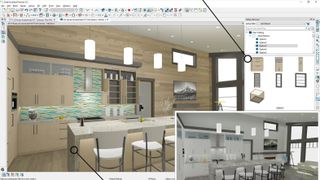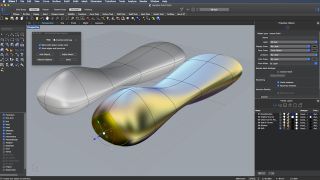Using the best CAD software will make it a lot easier to manage digital modeling projects. Our picks below are suitable for engineers, architects, game designers and 3D artists, looking for software that will help them create professional building designs and other models.
The best CAD software doesn’t come cheap and you’re unlikely to find any really good CAD software that’s completely free. As such, it’s really important to make sure that the program you buy is well suited to your needs.
If you really don’t want to spend any money, some of the options below have a basic free version that’s adequate for complete beginners. But it’s worth bearing in mind that a lot of these CAD programs will be available for free or at discounted prices for students, so if you are in education check with your school to see if they can help set you up.
In general, modeling software is easiest to operate on Window PCs or MacBooks, especially if you have a drawing tablet and stylus hooked up. However, a few of the CAD software options below are available as an app, too.
Working on a redesign of your home? Take a look through our round-ups of the best home design software and the best interior design software as well.
1. Autodesk Autocad: Best CAD software overall
Why you can trust Top Ten Reviews

Autodesk Autocad is described as a mid-level CAD program. This means it's easy to learn and ideal for beginners, yet it is still well loved and used by professional constructional engineers and architects.
Autocad offers 2D and 3D drawing tools and allows you to add annotations, hatching and lighting effects to your designs. To speed up the process you can use pre-built objects to create things like walls, windows and doors. Refine by changing the transparency of specific elements or adjust the lighting to present your creations more realistically with photorealistic rendering to finish.
The interface is designed to be user friendly and as such is relatively intuitive. But this is still aimed at professionals so expect a learning curve. That said, many builders do use BIM, so if you're moving that way then Autodesk Revit might be more suitable for you.
This program also has impressive file compatibility, which gives you plenty of importing and exporting options, and the AutoDesk user community is very active, so you'll be able to find plenty of help from the official user forum or from user-made tutorials. That said, the unlimited tech support from AutoDesk is a really useful resource too.
2. SketchUp: Best budget CAD software

SketchUp is a great CAD program for beginners, not only because of the intuitive way it works but also because it offers a totally free version. This also has a Pro paid for version, so you know this is high-quality. The free model is available as a more stripped down version for those that don't want or need to pay for the full version.
You can rearrange and customize the tools so you can easily access the ones you use most often. These tools are easier to use than many other programs, but they still require some practice. You can use this software to create believable and intricate 2D designs as well as 3D models. SketchUp also provides plenty of materials for adding texture to your creations.
It is compatible with both Windows and Mac, but doesn't work with DWF, DGN or STEP files, which can limit your output options.
3. Catia: Best for collaborative work

Catia is a super powerful CAD program for both expert and advanced designers as well as engineers. It is known as being both one of the most powerful programs on the market as well as one of the most expensive.
If you are planning on using this program, you will need professional training, either through school or through the company's learning courses. That said, it's built to work well with professionals in collaboration. This has cloud based support and allows for work across sites with relative ease.
In spite of being a difficult program, it is actually the preferred program for many engineers. It gives you more creative freedoms with design options, and it allows you to edit specific sections of your creations.
You will need to contact a Catia salesperson to determine how much this software will cost you. Just know that it will cost several thousand dollars and isn't a good choice for a hobbyist.
4. 3DS Max: Best for flexibility

3DS Max is another Autodesk program which offers a huge selection of very powerful plugins. This makes it really customizable and offers a CAS design platform that can change and grow as you do.
This is all about the 3D modelling, as the name suggests. It can offer fly-through animations for a finished project that makes it ideal for sharing. Add different plugins to suit your needs with set packages for media work and entertainment, production design and manufacturing, or architecture, engineering and construction. That last one includes AutoCAD and Civil 3D as standard.
Tools offer structural analysis , steel detailing, building performance analysis and vehicle path calculations to name a few building focused options. Pay with an annual subscription and save money by paying for longer commitments up front.
5. Chief Architect: Best for home design

Chief Architect is the go-to CAD software for anyone looking to do home designs. This is a relatively easy to use tool with intuitive interface that makes it great for use not only by professionals but also by homeowners looking to remodel.
There are different levels of product available to suit your needs. You could focus on the interior alone, costing you less. Or, if you want to design the whole home from the ground up then you may want to spend more and go for the Premier version of the product.
Using the top end versions it's easy to quickly construct 3D models or interior and exterior spaces. You can add them to 2D plans for a more realistic look at what remodelling could make the property look like.
6. Rhino 7: Best for curves

Rhino 7 is one of the few systems on this list which works on Mac and Windows PC but also on iOS making it iPad friendly. That's ideal for those using a stylus like the Apple pencil as this software is all about curved lines. As such it's a great bit of kit for anyone working on car design or road architecture.
From curved lines to meshes and NURBS surfaces, Rhino 7 is built to handle it all well thanks to a powerful modeller. There are also plenty of plugins and third-party add-ons that make the potential of this software great.
This also works with add-ins, like the Grasshopper visual programming system, allowing it to be tailored to specific tasks. That flexibility allows you to automate otherwise complex modelling and detailing as needed for speedy workflow.
Another positive is upgrades aren't forced and are usually charged at half the rate of a new license.
How Much Does CAD Software Cost?
The answer to this question really depends on the level of computer aided design you are planning on doing. The most basic programs only cost between $100 and $1,000, and many manufacturers offer student edition licenses that last a year, either at discounted prices or for free; however, professional programs – the kind used by large corporations and design professionals – will cost thousands of dollars a year in subscriptions. Many programs also only come with a limited amount of free technical support before you’re required to pay for a subscription. These costs can add up over time, so keep that in mind when choosing your software.
You will need to contact a sales representative to initiate the purchasing process for professional-level software and to check your eligibility for student discounts.
What are the different types of CAD?
As you look at various CAD software programs, you’ll quickly realize that some programs specialize in a specific type of CAD. You want to make sure the program you buy matches the type of work you want to do. There are two basic types of CAD: 2D CAD and 3D CAD.
As the name suggests, 2D CAD mainly works with two-dimensional drawings using basic geometry like lines and shapes. According to DesignTech Systems, 2D CAD was first developed in the 1970s for engineering companies. This type of software is helpful when drafting architectural blueprints, product schematics and other 2D engineering layouts.
3D CAD introduces the z-axis, so you can create more realistic models of your plans. It can be broken into three categories: wire-frame models, surface models and solid models.
Wire-frame models are best explained by picturing the 3D look of the original Tron movie. Elements of your designs are displayed as lines, and the background is visible through the design. This style isn’t as popular as it used to be, but it still has its uses, such as for artistic effect.
Surface models allow you to add textures and surfaces, such as shiny, metal car bodies, to your designs. Indovance states “it lacks the 'watertight' feature of solid modeling because if you were to cut into the design, it would be hollow.” Surface modeling is mainly used for aesthetic purposes and visualization.
Solid models apply the same attributes as surface models but also take into account weight, volume and density. This helps engineers understand how their designs work in the real world, taking into account things like gravity. This type of CAD is necessary when calculating any weaknesses or errors in your designs. For this reason, solid models are usually considered the most important and helpful category of 3D CAD.
CAD software: What to look for
When shopping for computer-aided design software, a few features and tools stand out as key indicators of good software. During our research, we found that tools like a command line and the house wizard were included with the best CAD software. They also often had comprehensive video tutorials and a few others.tools that helped make them more useful.
You should look for CAD tools that facilitate your specific interests. If you want to create architectural designs, for instance, you will want the best 3D modeling tools you can find. You should have the ability to create textures for different floor plans, as well as a high-functioning wall tool that makes creating walls simpler. If you don’t have a lot of experience, the house wizard is an invaluable tool that walks you through the process of building a virtual structure.
CAD programs often cater to a specific field, whether that be architectural, electrical, mechanical or technical, so you need to make sure you choose a program that best fits your needs.
Since each CAD software program has its own strengths and weaknesses, it isn’t uncommon for engineers and designers to work in multiple programs during the course of a project. You’ll just need to decide which ones work best for you. Here are some things to look for when deciding on the right program:
Design Tools
Designing 2D and 3D models is the essence of any good CAD program, so you'll want to be sure your choice has all the right tools. Some programs are only for 2D drawings or 3D modeling, but the best software has plenty of features for both.
For architectural designs, look for a wall tool and house wizard that do some of the work for you. The wizard will guide you through a step-by-step process to design a house by taking the information you provide and creating a preliminary design that you can then revise to your liking.
Photorealistic rendering is another important feature. It enables you to see what your finished designs will look like. Some programs have more realistic and powerful rendering than others and can help your designs look more professional.
All of these tools come with a learning curve, however. The engineers we spoke to told us that since CAD programs offer so many tools and have so many features, you can expect it to take one to two years to learn how to use advanced programs like CATIA or PTC Creo. Simpler programs might take less time, but it will depend on how often you use the software and how much training you receive.
Editing Tools
CAD packages should come with many different editing tools. Point markers and layer managers can help you keep your designs organized, and text and color editing allow you to keep notes and differentiate between various elements and pieces of your project. Another editing tool is the snap tool, which allows the shapes and lines that you draw to be snapped to a specific point on your drawing.
Some programs also come with 2D and 3D symbols and include models, so you can use the model as your base rather than creating each small element from scratch.
Some programs also come with an editing tool that allows you to virtually test models for weaknesses. The electrical engineer we interviewed informed us that the best programs allow you to "simulate the living daylights" out of your designs to find and fix any weaknesses before physical production begins, and the mechanical engineer we spoke with said that SolidWorks' powerful error finding tools are one of the reasons why he uses that program.
Compatibility
Whether you're working with a team or by yourself, you'll need to be able to present and utilize your designs. File compatibility is one aspect of CAD drawing software you don't want to overlook. DWG (a file format used in 2D and 3D drawings), DXF (Drawing Interchange Format), DWF (Design Web Format) and DGN (used for large scale projects and similar to DWG) are the most important formats to look for if you're working with AutoCAD.
Additionally, an STL export feature is handy for 3D printing. And for printing or emailing read-only files, look for PDF and various image file formats.
User Interface
Many programs have resources and features to make the learning process easier. The best programs have customizable tool palettes, a command line – where you type in a command like "symbol" and the program will pull the appropriate menu or dialogue box – and the ability to import existing designs from another location.
The best programs will also have a setup manager, which lets you change the settings on your document, and macro recordings, which let you consolidate and easily access frequently used command strings.
Help & Support
Both 3D and 2D CAD software programs can be hard to learn, so it’s nice to have a support network to walk you through the process. Email is the main source of direct contact with many CAD software manufacturers, but the some companies offer phone support as well. Also, some technical support is only included for free for a limited time, so be sure to read the fine print before you install your software.
Video tutorials, an in-program manual and community forums are also convenient sources for additional help. Many of the websites have video tutorials and PDF manuals you can download. You can also find a wealth of helpful instructional videos on YouTube.

